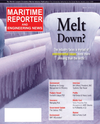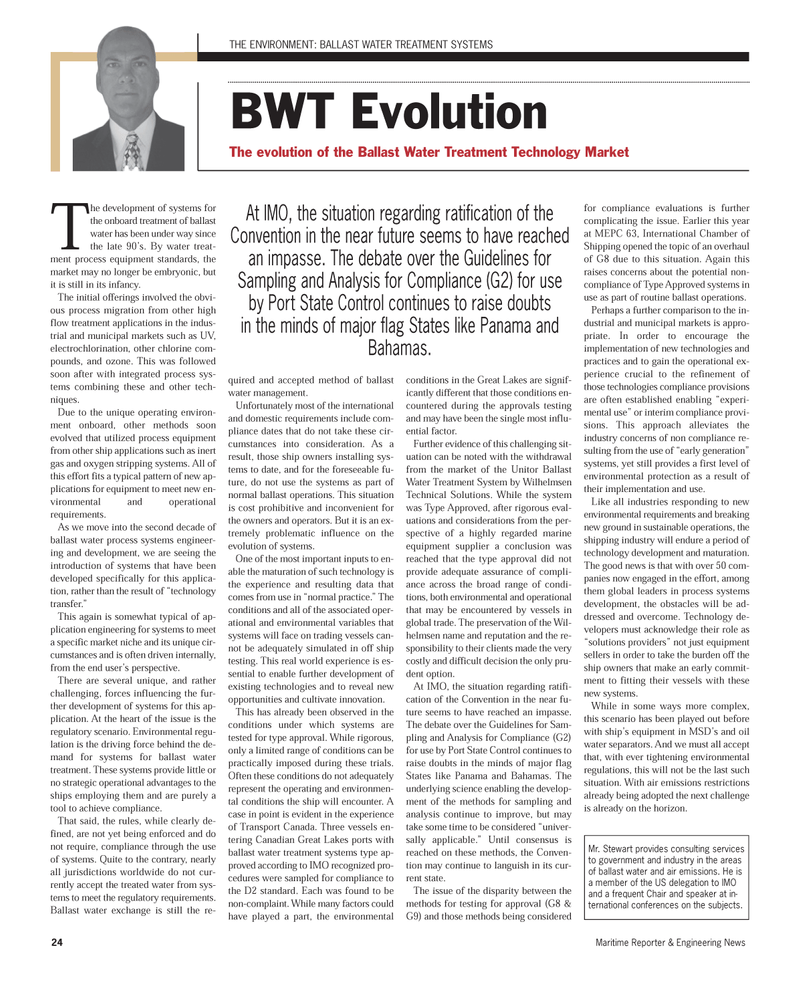
Page 24: of Maritime Reporter Magazine (May 2012)
The Green Ship Edition
Read this page in Pdf, Flash or Html5 edition of May 2012 Maritime Reporter Magazine
24Maritime Reporter & Engineering News The development of systems for the onboard treatment of ballastwater has been under way since the late 90?s. By water treat- ment process equipment standards, themarket may no longer be embryonic, but it is still in its infancy. The initial offerings involved the obvi- ous process migration from other highflow treatment applications in the indus- trial and municipal markets such as UV, electrochlorination, other chlorine com-pounds, and ozone. This was followed soon after with integrated process sys- tems combining these and other tech-niques. Due to the unique operating environ- ment onboard, other methods soonevolved that utilized process equipment from other ship applications such as inertgas and oxygen stripping systems. All of this effort fits a typical pattern of new ap- plications for equipment to meet new en- vironmental and operationalrequirements.As we move into the second decade of ballast water process systems engineer- ing and development, we are seeing the introduction of systems that have been developed specifically for this applica- tion, rather than the result of ?technologytransfer.? This again is somewhat typical of ap- plication engineering for systems to meeta specific market niche and its unique cir- cumstances and is often driven internally, from the end user?s perspective. There are several unique, and rather challenging, forces influencing the fur- ther development of systems for this ap- plication. At the heart of the issue is the regulatory scenario. Environmental regu- lation is the driving force behind the de- mand for systems for ballast water treatment. These systems provide little or no strategic operational advantages to the ships employing them and are purely a tool to achieve compliance. That said, the rules, while clearly de-fined, are not yet being enforced and do not require, compliance through the useof systems. Quite to the contrary, nearly all jurisdictions worldwide do not cur- rently accept the treated water from sys- tems to meet the regulatory requirements. Ballast water exchange is still the re- quired and accepted method of ballastwater management. Unfortunately most of the internationaland domestic requirements include com-pliance dates that do not take these cir- cumstances into consideration. As a result, those ship owners installing sys- tems to date, and for the foreseeable fu-ture, do not use the systems as part ofnormal ballast operations. This situation is cost prohibitive and inconvenient for the owners and operators. But it is an ex- tremely problematic influence on theevolution of systems. One of the most important inputs to en-able the maturation of such technology isthe experience and resulting data that comes from use in ?normal practice.? The conditions and all of the associated oper- ational and environmental variables that systems will face on trading vessels can- not be adequately simulated in off ship testing. This real world experience is es- sential to enable further development of existing technologies and to reveal new opportunities and cultivate innovation. This has already been observed in the conditions under which systems aretested for type approval. While rigorous, only a limited range of conditions can bepractically imposed during these trials.Often these conditions do not adequatelyrepresent the operating and environmen- tal conditions the ship will encounter. A case in point is evident in the experience of Transport Canada. Three vessels en- tering Canadian Great Lakes ports with ballast water treatment systems type ap- proved according to IMO recognized pro- cedures were sampled for compliance tothe D2 standard. Each was found to be non-complaint. While many factors could have played a part, the environmental conditions in the Great Lakes are signif- icantly different that those conditions en- countered during the approvals testing and may have been the single most influ- ential factor. Further evidence of this challenging sit- uation can be noted with the withdrawal from the market of the Unitor Ballast Water Treatment System by Wilhelmsen Technical Solutions. While the system was Type Approved, after rigorous eval- uations and considerations from the per- spective of a highly regarded marine equipment supplier a conclusion was reached that the type approval did not provide adequate assurance of compli- ance across the broad range of condi-tions, both environmental and operational that may be encountered by vessels in global trade. The preservation of the Wil- helmsen name and reputation and the re-sponsibility to their clients made the very costly and difficult decision the only pru- dent option.At IMO, the situation regarding ratifi- cation of the Convention in the near fu- ture seems to have reached an impasse. The debate over the Guidelines for Sam- pling and Analysis for Compliance (G2) for use by Port State Control continues toraise doubts in the minds of major flagStates like Panama and Bahamas. The underlying science enabling the develop- ment of the methods for sampling andanalysis continue to improve, but may take some time to be considered ?univer- sally applicable.? Until consensus is reached on these methods, the Conven- tion may continue to languish in its cur- rent state.The issue of the disparity between themethods for testing for approval (G8 & G9) and those methods being consideredfor compliance evaluations is further complicating the issue. Earlier this yearat MEPC 63, International Chamber ofShipping opened the topic of an overhaul of G8 due to this situation. Again this raises concerns about the potential non-compliance of Type Approved systems in use as part of routine ballast operations.Perhaps a further comparison to the in-dustrial and municipal markets is appro- priate. In order to encourage theimplementation of new technologies and practices and to gain the operational ex- perience crucial to the refinement of those technologies compliance provisions are often established enabling ?experi- mental use? or interim compliance provi- sions. This approach alleviates the industry concerns of non compliance re-sulting from the use of ?early generation?systems, yet still provides a first level of environmental protection as a result of their implementation and use.Like all industries responding to new environmental requirements and breaking new ground in sustainable operations, the shipping industry will endure a period oftechnology development and maturation. The good news is that with over 50 com- panies now engaged in the effort, among them global leaders in process systemsdevelopment, the obstacles will be ad- dressed and overcome. Technology de- velopers must acknowledge their role as ?solutions providers? not just equipment sellers in order to take the burden off the ship owners that make an early commit- ment to fitting their vessels with these new systems. While in some ways more complex, this scenario has been played out beforewith ship?s equipment in MSD?s and oil water separators. And we must all accept that, with ever tightening environmental regulations, this will not be the last such situation. With air emissions restrictions already being adopted the next challenge is already on the horizon.THE ENVIRONMENT: BALLAST WATER TREATMENT SYSTEMS BWT EvolutionThe evolution of the Ballast Water Treatment Technology Market Mr. Stewart provides consulting services to government and industry in the areas of ballast water and air emissions. He isa member of the US delegation to IMOand a frequent Chair and speaker at in- ternational conferences on the subjects. At IMO, the situation regarding ratification of the Convention in the near future seems to have reached an impasse. The debate over the Guidelines for Sampling and Analysis for Compliance (G2) for useby Port State Control continues to raise doubts in the minds of major flag States like Panama andBahamas. MR May 12 # 3 (17-24):MR Template 5/8/2012 11:38 AM Page 24

 23
23

 25
25
